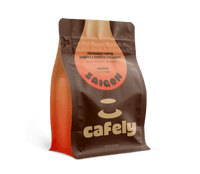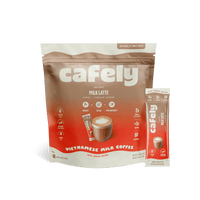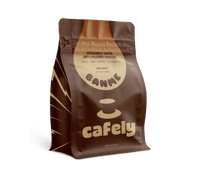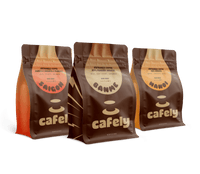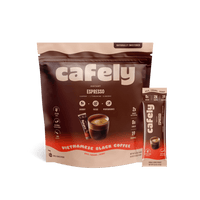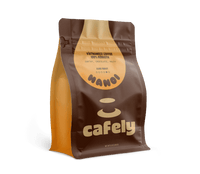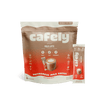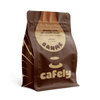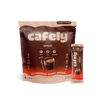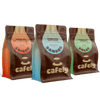There are quite a few kinds of coffee drinks — latte’s cappuccinos, flat whites, Americano’s, machiatos, mochas, and more.
So, what makes a latte stand out? How is it different from all the other delicious coffee/milk preparations you can buy?
This guide goes over the details and uncovers expert tips so you can learn how to make the perfect latte at home.
What is a Latte?
A latte (or caffè latte), is a creamy coffee drink made with espresso and steamed milk. Latte's are normally topped with light foam, enhancing the texture and lightness of the drink.
Steamed milk makes a velvety consistency, perfect alongside a bold espresso. This infuses the drink with rich coffee notes and turns the latte into its familiar honey-toned color.
Key ingredients in a caffe latte include:
- Espresso
- Steamed milk
- Milk foam
- Choice of sweetener/flavorings (optional)
The milk you use for a caffè latte depends on personal preference. Full-fat dairy milk creates thick, delicious steamed milk, but other options are available. Plant-based alternatives such as almond, oat, or soy add a sweet earthiness.
Comparing Coffee Drinks: Latte’s, Cappuccino’s, Breve, Flat White, & More:
|
Drink Name |
Coffee |
Milk |
Foam |
|
Latte |
2 oz espresso |
10 oz steamed milk |
.5 ounce foam |
|
Cappuccino |
2 oz espresso |
2 oz steamed milk |
2 oz foam |
|
2 oz espresso |
3 oz half-and-half |
N/A |
|
|
Flat White |
2 oz espresso |
4 oz steamed milk |
N/A |
|
Macchiato |
2 oz espresso |
6 oz steamed milk |
2 dollops of foam |
|
4 oz strong coffee |
3 tablespoons sweetened condensed milk |
N/A |
How to Make a Latte Coffee At Home (Step-By-Step)
Making a latte boils down to using milk that can steam and froth well, and choosing a bold, quality coffee for a shot of espresso. You also need the correct brewing method and grind size.
Tools Needed
Using the correct equipment will make your latte process quicker and easier:
- Espresso Machine — The most essential tool for making a latte, as it brews the espresso and usually has a steam wand for frothing milk.
- Coffee Grinder — Whole beans and a grinder are necessary to achieve the fine grind needed for espresso. Otherwise, a coffee shop can grind it for you.
- Tamper — Used to press the coffee grounds evenly in the espresso machine's portafilter.
- Milk Frother or Steam Wand -— Most espresso machines come equipped with one; if not, a separate milk frother will work.
- Thermometer (optional) — Helps in achieving the perfect milk temperature without scalding.
- Latte Cup — A large cup to accommodate the volume of milk and espresso.
Ingredients
So, what’s in a latte?
- Espresso Coffee Beans — High-quality beans will yield the best flavor; a dark roast like our HaNoi, is preferred.
- Milk — Any type can be used depending on dietary preferences; whole milk froths the best, but alternatives like oat, almond, or soy also work.
- Water — Fresh, filtered water for brewing the espresso.
- Optional Flavorings — Syrups like vanilla, caramel, or hazelnut can be added for a flavored latte.
By getting the right tools in action and using quality ingredients, you’ll have a tasty answer the next time someone asks what is a latte.
Choosing the Right Coffee For Latte’s
Lattes require shots of espresso, which gives the drink a dark, rich flavor. Dark espresso roasts work best but feel free to try other dark beans when looking for the best coffee options for latte.
Cafely's SaiGon OG is an excellent choice since it has a balanced blend of robusta, arabica, and peaberry. This unique blend is bold yet balanced when paired with steamed milk. Other dark coffee beans, such as Cafely's HaNoi and BanMe Coffee, provide robust flavor and depth.
Mastering the Espresso
Espresso is a concentrated coffee, usually served in 1 or 2 oz servings, with or without milk. It’s brewed using pressure, as the water is forced through the fine grounds. Many other methods — like automatic drip and Aeropress — require the coffee beans to steep in the water as it passes through them.
Step 1: Measure the Coffee
Measure the finely ground coffee needed to make your espresso. Usually, it's 18 g of coffee beans for a double or 9 g for a single espresso shot. However, you only need to loosely fill it to the top of the portafilter if you’re using an espresso machine.
Alternatively, if you don't have an espresso machine, you can use either a moka pot or phin filter. These tools don’t work quite as well but are the best alternative for producing the strong, concentrated flavors required for making latte’s.
Step 2: Tamp the Grounds
Tamping the coffee grounds helps remove any air gaps or pockets. Minimizing lumps and bits creates an even surface of coffee grounds. This allows water to flow through so the coffee can be evenly extracted.
Step 3: Pour Your Shot(s)
Attach the portafilter to your machine and fire it up. It should take about 10–30 seconds to finish pouring your shot.
Milk Frothing Technique
Once you’ve got your espresso shot ready (or a strong moka or phin coffee), you’ll need to froth your milk.
A bed of steamed milk with espresso and a layer of frothy milk is fundamental to a latte. Making frothed milk isn't difficult when using equipment such as a steamer or frother. Both of these tools create a silky smooth latte you'll be excited to drink every day.
Step 1: Choose Your Milk
Different milks will produce different lattes. Milk like almond and hazelnut add a wonderful nuttiness to lattes. Subtle-flavored milk makes a tasty treat when paired with complementing flavored syrup.
Full-fat dairy milk steams into a velvety delight, maintaining airiness alongside an espresso. Alternatives like almond or soy milk are subtly sweet with a thinner texture than full-fat options and don’t froth as well, if at all.
- Dairy milk — It has a luscious rich texture, but the high fat content of full-fat milk makes it a high-calorie option. Lower calorie options include 2% milk or skimmed milk.
- Plant-based milk — The array of dairy-free alternatives is ever-increasing. Options include almond, oat, hazelnut, soy, and rice milk, among others. These can contain natural sugars, but many options add sugar or syrup for a sweeter result. Opt for unsweetened milk to have better control over the sugar content of your latte.
Related: How to Make Vegan Vietnamese Coffee
Step 2: Heat & Froth Your Milk
To become light and creamy, frothing milk is the answer. Pasteurized milk tends to be more stable under heat. Optimal steam frothing temperatures are around 122–140°F (50–60°C).
Use the steam wand on the espresso machine, paying close attention to how the texture thickens and aerates. Continue to steam or froth the milk until it's velvety smooth with minimal foam separation. Then, it's ready to unite with a bold shot of espresso.
If you don’t have a steam wand, heat the milk over the stove, then whisk it vigorously to create the froth once it starts to steam. Avoid boiling your milk; remove it from the heat right before it starts to bubble.
Serving Your Latte
Now, it's time to put it together. You might be tempted to just dump it all into your cup, but follow these steps instead.
A perfect blend of milk and espresso is what gives lattes their signature creamy texture. Achieving a light, silky milk may take a couple of tries, but once mastered, you can enjoy velvety lattes every day.
Latte layers include:
- Steamed milk
- Espresso
- Milk foam
- Flavored syrup (optional)
Each layer gives lattes a distinctive balance of creamy milk and coffee.
Lattes may only take 10 minutes to make, but every second counts. The espresso needs to be added to the milk right away for the best flavor.
Step 1: Pour Your Espresso Into a Cup
After you’ve brewed your espresso, pour it into a cup. Make sure you have the right ratio of espresso to milk. Add any flavored syrups at this time.
Step 2: Add the Steamed Milk (Slowly)
Slowly pour the steamed milk into the espresso, holding back the froth with a spoon. You'll want to pour very slowly while moving the milk around the cup so it mixes with the coffee without damaging any of the delicious foam on top.
Step 3: Top With Foam & Optional Latte Art
Once you’re finished pouring the milk into your coffee, you’ll be left with a layer of foam — make sure to transfer this to your coffee as well, but gently so it remains intact on the surface of the coffee. This foam helps maintain a consistent temperature and flavor in the coffee below.
If you’re feeling creative, try your hand at making some latte art.
Latte Flavor Variations & Enhancements
Exploring various ways of flavoring your latte allows you to experience something a little different each time you make a brew. Flavored syrups or additions include vanilla, caramel, and pumpkin spice. Each one diversifies your latte so you can change things up when you want to.
Syrup can be added to milk before steaming, allowing flavors to infuse the coffee evenly. It’s also possible to use regular sugar to sweeten a latte, or coconut sugar for a caramel undertone. Stevia and monk fruit are low-calorie choices providing sweetness without a hit of sugary carbs. Making your own coffee creamer is also a great way to match your sweetness preference.
FAQs: How to Make a Latte Coffee
Do you have more questions about what a latte is? If so, here are some popular questions answered by us:
1. What is the best coffee for a latte?
Cafely Sai Gon OG is highly recommended for lattes as it has a balanced and robust flavor. The dark roast creates a bold espresso base for the latte, which remains strong even when blended with steamed milk.
Dark-roasted arabica beans are the most common, but a good robusta coffee will take your espresso to another level.
Related: What’s the Difference Between Robusta & Arabica Coffee?
2. How much coffee do I need for one latte?
Typically, two shots of espresso (about 2 ounces) are needed to make one latte. This depends on the desired strength you want the latte to be, so adjust this according to your preferences.
Related: How Much Coffee Is Needed Per Cup?
3. Can I make a latte without an espresso machine?
Alternatives like an Aeropress, moka pot, phin filter, or regular French press can be used to make an espresso for a latte. Follow specific techniques and the correct water-to-coffee ratio.
4. What type of milk is best for a latte?
Whole milk is preferred for making lattes as it is naturally creamy, but oat milk is a great non-dairy alternative. If you're calorie-conscious, avoid using heavy dairy items like full-fat milk, which can increase the overall calories in your latte.
5. How do I froth milk without a frother?
Milk can still be frothed even if you don’t own a frother. A whisk works well for aerating milk, and a handheld one should do fine — it just takes a bit more time and effort! Heat the milk first, then whisk away. You can also pour milk into a jar and shake it.
6. Can I add flavors to my latte?
Adding flavor to your latte can be done using simple syrups or spices to customize your drink. Vanilla, caramel, and chocolate are popular options, offering flavorful sweetness. You can even try making ube latte for a colorful twist on your usual coffee routine.
7. What is the ideal temperature for steamed milk in a latte?
Aim to steam your milk at a temperature no higher than 150°F (65°C) to avoid scalding the milk and retain its sweetness.
8. How can I make a latte art at home?
Making latte art at home is possible, and means every latte you make can be decorated and welcoming. Practice pouring the milk with a steady hand to create designs.
9. How do you make an iced latte?
An iced latte is easy to make and can be done by cooling the espresso and opting for cold milk. Serve the latte over ice for a refreshing treat during summer.
10. How long does it take to make a homemade latte?
A homemade latte created from scratch takes around 10 minutes to make. This factors in the time needed to prepare the steamed and frothed milk and brew the espresso. It may take more or less time to make a latte at home, depending on your setup and experience.
